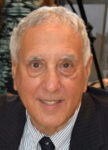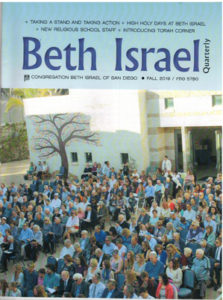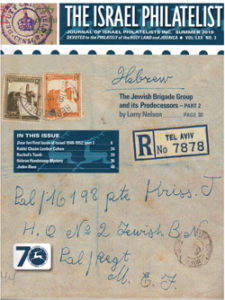Items in today’s column include:
*Eight Jewish candidates to date; two more would make a minyan
*Beth Israel Quarterly provides personal insights into congregation’s leaders
*The Israel Philatelist Finds Jewish Stamp Stories the World Over
By Donald H. Harrison
Eight Jewish candidates to date; two more would make a minyan

SAN DIEGO — When Congresswoman Susan Davis announced her planned retirement from the 53rd CD, I wondered how many Jewish officeholders would be left in San Diego County.
Barbara Bry will complete her service as 1st District San Diego City Council seat to run for mayor of San Diego. She has formidable opposition from California Assemblyman Todd Gloria. Dr. Jen Campbell meanwhile will continue representing the 2nd City Council District.
But where else are there Jewish officeholders?
Bernie Rhinerson represents District B on the San Diego Community College Board, and he’s running for reelection with the endorsement of the San Diego County Democratic Party.
Congressman Mike Levin has a Jewish father, and a Christian mother, and says he was brought up with both religions. However, he does not self-identify as Jewish, so perhaps he should be considered as an ally, but not as an MOT.
Unless I’ve missed someone, that’s the extent of current San Diego-area Jewish officeholders, who are part of a long line of Jews in public service that goes all the way back to the 1850s when men like Louis Rose, Joseph S. Mannasse, and Marcus Schiller served on the City Board of Trustees, which was the forerunner of the City Council.
However, as I look at the list of candidates for public office, I’m confident that at least some of them who are Jewish will succeed.
Here’s a rundown by district.
In Davis’s 53rd Congressional District, Sara Jacobs, granddaughter of Qualcomm co-founder Irwin Jacobs, is a candidate. Her most formidable opposition seems to be San Diego City Council President Georgette Gomez in what could be a crowded field. Others who have announced thier intentions are Jose Caballero, John-Christian Carey, and Joaquin Vazquez.
In the 78th Assembly District, where Todd Gloria will complete his service in order to run for mayor, two Jewish candidates–both of them Democrats–have emerged. They are Sarah Davis, a member of Ohr Shalom Synagogue, and Micah Perlin, who told me he had his bar mitzvah at Congregation Beth El. Also running in that district is San Diego City Councilmember Chris Ward.
In the 3rd Supervisorial District, Terra Lawson-Remer and Olga Diaz are challenging incumbent Kristin Gaspar. Terra is the daughter of longtime San Diego political consultant Larry Remer. Rabbi Laurie Coskey and Cantor Larry Kornit recently officiated at a naming ceremony for her daughter, Eeva Kai Luna Lawson-Remer. The candidate’s campaign manager, Spencer Katz, also is Jewish.
In the San Diego City Attorney’s race, Cory Briggs is challenging incumbent Mara Elliott. Briggs is a member of Congregation Beth Israel.
In the 5th San Diego City Council District, where Mark Kersey is being termed out, attorney Joe Leventhal, a former city Ethics Commissioner, is a candidate.
There may be other Jewish candidates as yet not identified to me, or who may still be mulling the idea of running for political office in the March 3, 2020 election. Rhinerson, Bry, Jacobs, Davis, Perlin, Lawson-Remer, Briggs, and Leventhal. Two more would make a minyan!
Why have Jews been so interested in holding elective office in this region ever since California became a state? I believe it stems from a sincere belief that as Jews, it is our duty to do tikkun olam — often translated as “repair of the world.”
Not every local Jewish officeholder has ended up with a sterling record — witness the sad demise of former San Diego Mayor Bob Filner in a sex abuse scandal — but I believe that each one of them, including Filner, started with the best of intentions.
*
Beth Israel Quarterly provides personal insights into congregation’s leaders
 I always enjoy receiving the Beth Israel Quarterly in the mail because it reinforces my impression that Congregation Beth Israel is not only the largest congregation in our county, but also is very haimish. In this quarterly, clergy and officers of the Reform congregation share intimate stories about their families. You get the sense that you really can get to know these leaders, despite the 1100- family-unit size of the congregation.
I always enjoy receiving the Beth Israel Quarterly in the mail because it reinforces my impression that Congregation Beth Israel is not only the largest congregation in our county, but also is very haimish. In this quarterly, clergy and officers of the Reform congregation share intimate stories about their families. You get the sense that you really can get to know these leaders, despite the 1100- family-unit size of the congregation.
For example, in the current issue, Rabbi Jeremy Gimbel, who is the assistant rabbi/ educator, discloses that his grandfather was an atheist, who nevertheless made it a point to attend High Holy Day services. When his grandfather was a public-school student in New York, he was expelled for refusing to recite the Lord’s Prayer. The ACLU took on his case, and while it came to naught, it was the forerunner of a later case, Lemon v. Kurtzman, that prohibited prayer in public schools.
So why did grandpa want to attend High Holy Day services? “Because he understood that the High Holy Days are about more than the prayers we say, or the melodies we use, or even who is leading the service. The High Holy Days are about being together as a community to hear the call of the shofar, awakening in each of us the need to make things right and learn from our mistakes – no theological test required.”
Noting that the Jewish cycle of learning is never ending, Rabbi Martin S. Lawson, the emeritus rabbi of Temple Emanu-El who currently teaches Torah classes at Congregation Beth Israel, recalled that when he was in preschool, his rabbi, Leon Kronish, z”l, used to have him sit with the other pupils on a braided rug, on one occasion retelling the story of Noah and the flood. The story first learned in preschool subsequently became for Lawson a jumping off point for raisng “questions regarding the role of humankind in preserving our planet: the respect for all forms of life: the politicl, the religious and socio-cultural conditions that emerge from Noah’s story.”
Kimberly Carnot, the congregation’s president, wrote about how her world view changed over the years. As a youngster, she recalled, she once visited a gay and lesbian synagogue that “felt like a field trip to a museum because I had no intention to return, no reason to build relationships.” Today she and her wife, Traci Carpenter, are raising two children in the temple’s community, and she understands the needs everyone has to make connections and to have a supportive community. As a teenager she visited Israel, and wondered why anyone would want to live in a place where bombings came often and deep hatreds persisted. Now, she writes, My love for Israel and understanding of the importance of the Jewish Sate has grown as I have evolved through learning and engaging in challenging discussions…”
Rabbi/ Cantor Arlene Bernstein, the acting senior rabbi, said some of her colleagues in the Jewish world do not believe it is necessary any more to commemorate Tisha B’Av, the day in history when both the First and Second Temples in Jerusalem were destroyed, because, after all, Jerusalem is back in Jewish hands. Nevertheless, she said, she is among those who believes it is “extremely important to remember and reinforce our history, and not to forget what happens when hate and destruction are allowed to reign.”
There’s plenty to think about in Beth Israel’s Quarterly and I’m glad I’m on that congregation’s mailing list.
*
The Israel Philatelist Finds Jewish Stamp Stories the World Over
 Another quarterly publication that I enjoy receiving is The Israel Philatelist, which is edited by Donald Chafetz at his El Cajon home. The quarterly has an interesting variety of stories that discuss various postal items not only in philatelic terms but also in terms of their historic and personal backgrounds.
Another quarterly publication that I enjoy receiving is The Israel Philatelist, which is edited by Donald Chafetz at his El Cajon home. The quarterly has an interesting variety of stories that discuss various postal items not only in philatelic terms but also in terms of their historic and personal backgrounds.
While the name of the publication may suggest that Israeli stamps are its only focus, in fact the magazine searches the world for interesting Jewish stories connected to stamps, first day covers, cancellations, censor overprints, and the like.
I was particularly interested in a story by Gene Eisen about the famous geniza at the old Ben Ezra Synagogue in Cairo. I learned that in 2004, Egypt issued a stamp depicting the interior of the synagogue as part of a nine-stamp booklet pane commemorating important religious sites in Egypt.
Seven years prior to that, Israel issued a souvenir sheet that included a composite picture of the synagogue’s interior and a detail of a well-known photograph showing the Jewish scholar Solomon Schechter poring over some of the thousands of Hebrew-language manuscripts that had been thrown in the Geniza rather than being destroyed or buried.
Some of the other articles in the current issue of the glossy, high-resolution Israel Philatelist are an essay on the first stamp issue of Israel; philatelic covers honoring former U.S. Treasury Secretary Henry Morgenthau; postal covers from Oswego, New York, where the U.S. sheltered nearly 1000 refugees during World War II; envelopes sent to and from servicemen in the Jewish Brigade that served in Palestine during the 1940s; stamps relating to Albert Einstein and the solar eclipse that proved his theory that light bends; and pre-printed envelopes used by prisoners in Nazi concentration camps.
*
Harrison is editor of San Diego Jewish World. He may be contacted via donald.harrison@sdjewishworld.com